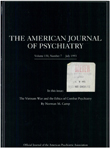Dopamine in schizophrenia: a review and reconceptualization
Abstract
OBJECTIVE: The initial hypothesis that schizophrenia is a manifestation of hyperdopaminergia has recently been faulted. However, several new findings suggest that abnormal, although not necessarily excessive, dopamine activity is an important factor in schizophrenia. The authors discuss these findings and their implications. METHOD: All published studies regarding dopamine and schizophrenia and all studies on the role of dopamine in cognition were reviewed. Attention has focused on post-mortem studies, positron emission tomography, neuroleptic drug actions, plasma levels of the dopamine metabolite homovanillic acid (HVA), and cerebral blood flow. RESULTS: Evidence, particularly from intracellular recording studies in animals and plasma HVA measurements, suggests that neuroleptics act by reducing dopamine activity in mesolimbic dopamine neurons. Post-mortem studies have shown high dopamine and HVA concentrations in various subcortical brain regions and greater than normal dopamine receptor densities in the brains of schizophrenic patients. On the other hand, the negative/deficit symptom complex of schizophrenia may be associated with low dopamine activity in the prefrontal cortex. Recent animal and human studies suggest that prefrontal dopamine neurons inhibit subcortical dopamine activity. The authors hypothesize that schizophrenia is characterized by abnormally low prefrontal dopamine activity (causing deficit symptoms) leading to excessive dopamine activity in mesolimbic dopamine neurons (causing positive symptoms). CONCLUSIONS: The possible co-occurrence of high and low dopamine activity in schizophrenia has implications for the conceptualization of dopamine's role in schizophrenia. It would explain the concurrent presence of negative and positive symptoms. This hypothesis is testable and has important implications for treatment of schizophrenia and schizophrenia spectrum disorders.
Access content
To read the fulltext, please use one of the options below to sign in or purchase access.- Personal login
- Institutional Login
- Sign in via OpenAthens
- Register for access
-
Please login/register if you wish to pair your device and check access availability.
Not a subscriber?
PsychiatryOnline subscription options offer access to the DSM-5 library, books, journals, CME, and patient resources. This all-in-one virtual library provides psychiatrists and mental health professionals with key resources for diagnosis, treatment, research, and professional development.
Need more help? PsychiatryOnline Customer Service may be reached by emailing [email protected] or by calling 800-368-5777 (in the U.S.) or 703-907-7322 (outside the U.S.).



